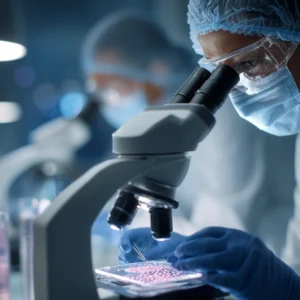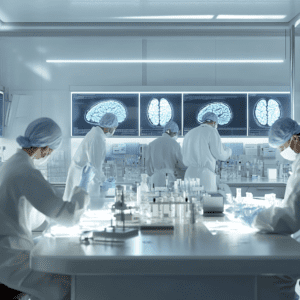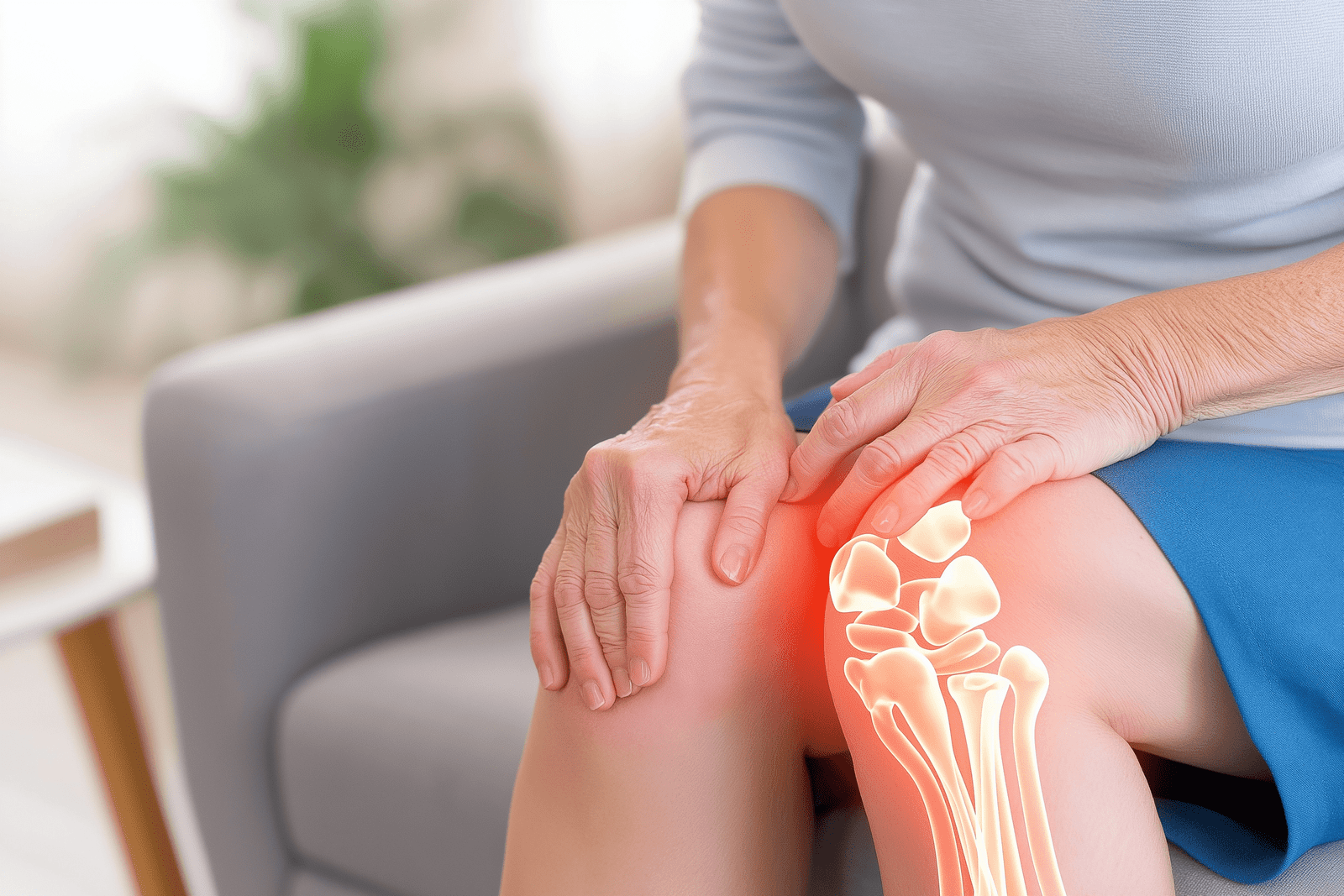Stem Cell treatments for ALS are being heavily studied, with some interesting data.
We’ve broken down each study in detail, but we know it’s a lot to digest.
At the start of the article, we’ve provided an initial summary of what all the research is telling us.
If you want to look at any study in particular, use the Content Table on the left to go to a particular study.
ALS Findings
What the Research Says About Stem Cells for Amyotrophic Lateral Sclerosis
Looking at the latest data, one type of cell therapy has shown significant breakthroughs by confirming positive biological effects and clinical signals in patients with ALS.
The primary type studied in human trials is the Mesenchymal Stem Cell derived from bone marrow. The most common delivery method is the spinal tap and many studies use multiple doses.
MSC therapy works primarily by calming inflammation and regulating the immune system. Acting as a protective shield to support the survival of existing nerves rather than replacing lost cells.
The data shows real clinical success for this approach. The therapy has been conditionally approved in South Korea & a major Phase 3 trial achieved a clear breakthrough by showing a significant, lasting benefit in a specific subgroup of slower-progressing patients. However, it wasn’t perfect, as you’ll read below.
Neural Stem Cells, explored for their potential to directly replace lost neurons, have so far only proven to be safe for injection, with no conclusive evidence that they can slow the disease in humans.
Induced Pluripotent Stem Cells are still in their early stages, with human trials only just beginning.
The big takeaway from researchers is that while bone marrow MSC therapy is the most advanced approach we currently have, science is still stuck on a major problem. Results aren’t consistent because trials have been too small and lacked proper control groups.
Current Stem Cell Trials looking at Amyotrophic Lateral Sclerosis
Here we break down the current trials looking at Stem Cells treating ALS.
Brainstorm-Cell Therapeutics: Phase 3b Stem Cell Trial for ALS: NurOwn / Debamestrocel: USA
You can read the full study details on ClinicalTrials.gov using the ID NCT06973629.
This is a large, two-part Phase 3b clinical trial sponsored by the company Brainstorm-Cell Therapeutics in the United States.
It is designed to evaluate the safety and effectiveness of their unique stem cell therapy, NurOwn (also called Debamestrocel), in people who have been recently diagnosed with ALS and have a moderate presentation of the disease.
The second part of the trial offers active treatment to all participants.
- Estimated Start Date: June 30, 2025.
- Estimated Completion Date: May 1, 2029.
- Recruitment Status: Not yet recruiting.
Participants
- Estimated Sample Size: Up to approximately 200 participants.
- Ages: 18 to 75 years old.
- Eligibility Focus: Participants must be in the early symptomatic phase with ALS symptoms starting within the last 24 months, showing moderate disease and good breathing function (Slow Vital Capacity ≥65% predicted).
Cell Type Used
- MSC-NTF Therapy: Uses Mesenchymal Stem Cells Secreting Neurotrophic Factors (MSC-NTF), trademarked as NurOwn.
- Cell Source: Derived from the patient’s own bone marrow.
- What They Are: The patient’s bone marrow cells are “super-charged” in the lab to produce and release large amounts of neurotrophic factors that protect and heal nerve cells.
- The Goal: Deliver protective proteins directly to damaged nerve cells in the spinal cord.
Delivery Method
- Intrathecal Injection: The cells are injected into the spinal fluid using a standard lumbar puncture (spinal tap).
- The Placebo: A nutrient solution that looks identical to the treatment but contains no active cells.
Cell Dosage
- Total number of cells per injection is not specified in current documents.
- Schedule: Both active treatment and placebo are administered every 8 weeks for three injections in the initial controlled phase (Part A).
Follow-up Schedule
- The trial runs for 48 weeks, split into two parts:
- Part A (24 Weeks): Randomized, double-blind, placebo-controlled phase. Participants receive either NurOwn or placebo every 8 weeks.
- Part B (24 Weeks): Open-Label Extension. All eligible participants who finish Part A receive the active NurOwn treatment every 8 weeks.
Primary Outcomes (What They Are Measuring)
- Effectiveness: Change in ALSFRS-R total score from baseline to Week 24.
- Safety: Tracking frequency and severity of Adverse Events throughout 48 weeks.
Other Outcomes
- Breathing Function: Changes in Slow Vital Capacity.
- Muscle Strength: Upper limb muscle strength measured with Hand-Held Dynamometry (HHD).
- Neurodegeneration: Levels of the nerve damage marker Neurofilament Light (NfL).
- Quality of Life: Patient self-reported ALSAQ-40 questionnaire results.
- Caregiver Burden: Zarit Caregiver Burden Interview (ZBI) to assess impact on caregivers.
Phase I IPSC Stem Cell Trial for Amyotrophic Lateral Sclerosis: Shanghai East Hospital: China
You can read the full study details on ClinicalTrials.gov using the ID NCT06765564.
This is an early-stage clinical trial sponsored by Shanghai East Hospital in China.
This non-randomized, open-label study is focused on IPSC stem cells.
The primary goal is to explore the safety of this new therapy in a small group of patients with ALS.
- Actual Start Date: March 13, 2024.
- Estimated Completion Date: May 13, 2025.
- Recruitment Status: Recruiting.
Participants
- Estimated Sample Size: 3 participants in this small, preliminary study.
- Ages: 18 to 60 years old.
- Eligibility Focus: Participants must have an ALS diagnosis between 6–24 months before screening and show good lung capacity (FVC ≥50%).
- Participants must take immunosuppressants for three months, as the therapy may use cells that could be rejected by the body.
Cell Type Used (iPSC-MNP)
- iPSC-MNP: Induced Pluripotent Stem Cells – Motor Neuron Precursors.
- What They Are: Adult stem cells guided to develop into the motor neurons that ALS destroys. These can originate from the patient or a donor.
- The Goal: Replace damaged motor neurons and protect existing ones by releasing growth factors and reducing inflammation.
Delivery Method
- Surgical Procedure: Multi-dose delivery directly into the brain.
- Surgical Implant: Under general anesthesia, patients have a Sofia drug pouch installed under the skin.
- Intraventricular Injection: Cells are injected through this pouch directly into the fluid-filled brain spaces.
Cell Dosage
- Dose per Injection: 50 million cells in a 2 mL solution.
- Schedule: Four total injections, administered every two weeks through the implanted pouch.
Follow-up Schedule
- Total treatment and observation period: approximately 7.5 months from the first cell injection.
- Safety and efficacy follow-ups at 1, 3, and 6 months after the final transplant.
- New subjects can only enroll after the prior subject completes 6 months of observation without serious side effects.
What They Are Measuring
- Primary Goal (Safety): Track any Adverse or Serious Adverse Events.
- Safety monitored via MRIs of the head and spine, blood tests, and vital sign checks.
Other Outcomes
- Functional Assessment: Changes in ALSFRS-R scores (functional ability scale).
- Cognitive & Mood Testing: Depression (HAMD 17), anxiety (HAMA), and cognition (MMSE, MoCA).
- Biomarkers: Spinal fluid tests for neurotrophic factors to confirm cell activity.
XellSmart: Phase 1 Stem Cell Trial for Amyotrophic Lateral Sclerosis: iPSC-Derived Motor Neuron Progenitor Cells (XS228CN): China
You can read the full study details on ClinicalTrials.gov using the ID NCT07118319.
This is a very early Phase 1 clinical trial sponsored by XellSmart Bio-Pharmaceutical in China.
The main purpose is to test the safety and tolerability of a Allogenic iPSC Cells, XS228CN, in a small group of ALS patients.
- Estimated Start Date: August 4, 2025.
- Estimated Completion Date: September 30, 2028.
- Recruitment Status: Not yet recruiting.
Participants
- Estimated Sample Size: 12 participants.
- Ages: 18 to 75 years old.
- Eligibility Focus: Participants must have definite or probable ALS and be in good general health, especially with strong breathing function (FVC ≥70%).
Cell Type Used: Allogeneic iPSC-MNP
- Therapy Type: Allogeneic iPSC-Derived Motor Neuron Progenitor Cells (XS228CN).
- What They Are: These cells come from a universal, healthy donor rather than the patient. Adult cells are reprogrammed into Induced Pluripotent Stem Cells and then guided to become Motor Neuron Progenitor Cells.
- The Goal: Introduce healthy nerve-precursor cells into the spinal fluid to replace lost motor neurons and improve nervous system function.
Delivery Method
- Intrathecal Injection: Cells are injected directly into the spinal fluid via lumbar puncture (spinal tap).
- No Placebo: This is an open-label trial, meaning all participants receive the active stem cell treatment.
Cell Dosage
- The trial tests four dose and schedule combinations to find the safest dose.
- Low Dose (50 million cells):
- Group 1: Single injection of 50 million cells.
- Group 2: Four injections of 50 million cells (every two weeks).
- High Dose (100 million cells):
- Group 3: Single injection of 100 million cells.
- Group 4: Four injections of 100 million cells (every two weeks).
Follow-up Schedule
- Main Safety Period: Safety monitored for 28 days after the final injection.
- Study Duration: Estimated to continue through late 2028.
What They Are Measuring
- The main objective is safetyrecording all treatment-related Adverse Events and Serious Adverse Events.
Other Outcomes
- Preliminary Efficacy: Collect early data on potential benefits of the therapy.
- Functional Assessment: Though not formally listed, ALS functional rating scales are typically used to track patient changes.
New England Cell Therapeutics: Phase II Bone Marrow MSC Stem Cell Trial for Amyotrophic Lateral Sclerosis (STR04): USA
You can read the full study details on ClinicalTrials.gov using the ID NCT06910384.
This is an Open-Label Phase 2 study sponsored by New England Cell Therapeutics. in the United States.
The trial is evaluating the safety and efficacy of their cell therapy, STR04, which uses a patient’s own stem cells.
- Actual Start Date: August 12, 2025.
- Estimated Completion Date: January 30, 2028.
- Recruitment Status: Recruiting.
Participants
- Estimated Sample Size: 9 participants.
- Ages: 18 to 75 years old.
- Eligibility Focus: Participants must be in the early stages of ALS (onset within 2 years) and have good functional ability, particularly with strong breathing function (FVC ≥80%).
Cell Type Used: Bone Marrow Derived Autologous MSC
- Therapy Type: Autologous Bone-Marrow-Derived Mesenchymal Stem Cells (STR04).
- What They Are: The patient’s own MSCs collected from bone marrow, then multiplied and prepared (“manufactured”) before re-injection.
- The Goal: MSCs are used for their potential to repair tissue, reduce inflammation, and secrete protective factors that support damaged nerve cells.
Delivery Method
- Intravenous (IV) Injection: The STR04 cells are delivered via IV infusion.
- No Placebo: This is an open-label study (no masking); all participants receive the active STR04 treatment.
Cell Dosage
- Cell Dose: The exact number of cells per injection is not specified.
- Schedule: Participants receive 4 doses of STR04, one every 12 weeks.
Follow-up Schedule
- Treatment Period: 4 doses given over 36 weeks (9 months).
- Final Assessment: The total study duration, including the final assessment, is 69 weeks.
What They Are Measuring
- Main Goals: Evaluate both effectiveness and safety.
- Effectiveness: Change in ALS Functional Rating Scale (ALSFRS-R) score at 25 weeks.
- Safety: Track treatment-related Adverse Events.
Other Outcomes
- Functional Decline: Change in ALSFRS-R score over the study period.
- Breathing: Monitor Percent-predicted Forced Vital Capacity (FVC).
- Muscle Strength: Measure using the Manual Muscle Test (MMT).
- Quality of Life: Track using the ALS Assessment Questionnaire (ALSAQ-40).
- Biomarker: Monitor changes in plasma neurofilament light (NfL), a marker of nerve damage.
Phase II Neural Stem Cell Trial for Amyotrophic Lateral Sclerosis (STEMALS): Italy
You can read the full study details on ClinicalTrials.gov using the ID NCT06344260.
This is a non-profit Phase 2 study sponsored by the Casa Sollievo della Sofferenza IRCCS in Italy.
The trial is a major step forward, as it is a highly controlled study testing the safety and effectiveness of a Neural Stem Cell therapy for ALS.
- Actual Start Date: January 25, 2024.
- Estimated Completion Date: September 2027.
- Recruitment Status: Recruiting.
Participants
- Estimated Sample Size: 30 participants.
- Ages: 18 to 65 years old.
- Eligibility Focus: Patients with fast disease progression, early-stage ALS (onset ≤24 months), and strong breathing function (FVC >70%).
- Participants must tolerate a temporary immunosuppressant regimen.
Cell Type Used (Allogeneic Neural Stem Cells)
- Therapy Type: Allogeneic Human Neural Stem Cells (hNSC).
- What They Are: Factory-produced stem cells, not from the patient, created under strict GMP standards. These are the source cells for all nerve cells in the brain and spinal cord.
- The Goal: Replace lost neurons and release protective factors directly into damaged areas of the brain.
Delivery Method
- Intracerebroventricular Transplantation: Cells are delivered directly into the brain’s fluid spaces (lateral ventricle).
- Surgical Reservoir: Delivered through an Ommaya reservoir implanted beneath the scalp for precise, direct injections.
- Controlled vs. Placebo: Randomized, placebo-controlled, triple-blind trial — some patients receive the active cells, others receive saline (placebo).
Cell Dosage
- Phase A (Safety/Dose-Finding): Six patients initially test two dose levels for safety.
- Phase B (Main Trial): Patients randomized into three groups:
- Low Dose: 20 million hNSCs.
- High Dose: 40 million hNSCs.
Follow-up Schedule
- Study Duration: Main study phase (Phase B) lasts approximately 24 months.
- Long-Term Monitoring: All patients will undergo lifelong safety monitoring due to the advanced nature of the therapy.
- Crossover Design: Patients receiving placebo will later be re-randomized to an active cell dose after three months, ensuring all eventually receive treatment.
What They Are Measuring
- Main Goal: Safety — track treatment-emergent and serious Adverse Events over the first 12 months.
Other Outcomes
- Biomarker Levels: Measuring biomarkers in spinal fluid and blood, including inflammatory markers.
- Cell Modeling: Creating patient-specific cell models (from blood and skin) to produce iPSCs and NSCs for studying treatment mechanisms.
Previous Trials looking at Stem Cells for Amyotrophic Lateral Sclerosis
We break down all the latest research looking at Stem Cells for ALS since 2020.
Brainstorm Phase III Autologous MSC Stem Cell Trial for Amyotrophic Lateral Sclerosis: Multi-Center USA Study: 2022
You can read more about this study on Wiley’s Online Library.
This large clinical study tested whether stem cell therapy could safely slow down disease progression in people with amyotrophic lateral sclerosis (ALS).
Researchers compared three injections of the stem cells against three injections of a placebo over 28 weeks to see if the treatment was effective.
The main goal was to see if the therapy could slow the rate of decline as measured by the ALS Functional Rating Scale.
The work was led by a team of researchers from six major US academic centers, including the Healey Center at Mass General Hospital and UC Irvine Health
Research Summary
The study did not meet its primary goal. The group receiving the stem cell therapy did not show a statistically significant slowing of their disease progression compared to the placebo group.
However, the therapy was confirmed to be safe and well-tolerated with no safety concerns identified.
Participants
- 196 adults with ALS were randomly assigned to the two treatment groups.
- The study was conducted at six different academic centers across the United States.
- The trial included a significant number of participants with more advanced ALS.
Delivery Method
- Each participant received three injections intrathecally into the spinal fluid.
- The injections were performed using a standard lumbar puncture and were spaced eight weeks apart.
Cell Type & Source
- Autologous Mesenchymal Stem Cells induced to secrete Neurotrophic Factors (MSC-NTF).
- Source: The patient’s own bone marrow.
Cell Preparation
- Mesenchymal stem cells were collected from the patient’s bone marrow.
- The cells were treated in a lab under “proprietary conditions” that reprogrammed them to produce and secrete high levels of neurotrophic factors.
Dosage
- The study does not specify the exact number of cells contained in each injection.
Safety
- The treatment was safe and well-tolerated.
- Most side effects were mild to moderate, temporary, and related to the lumbar puncture procedure itself.
- There were no deaths related to the treatment.
Clinical Improvements (Primary Outcome)
- The study failed to meet its primary endpoint.
- There was no statistically significant difference in response between the stem cell group (33%) and the placebo group (28%).
Other Key Findings (Biomarkers & Subgroup)
- Improved Biomarkers: The therapy led to large and statistically significant improvements in key biomarkers in the spinal fluid.
- Neuroprotection: Levels of VEGF, a protective factor for motor neurons, increased significantly.
- Reduced Inflammation & Degeneration: Levels of MCP-1 and NfL were significantly reduced.
- Subgroup Analysis: In patients with less severe disease (ALSFRS-R score ≥ 35), response was 35% vs. 16% for placebo (not statistically significant).
How the Cells Worked
- The therapy was designed to support the nervous system, not to replace or rebuild it.
- The modified cells secrete high levels of neurotrophic factors directly into the spinal fluid.
- These proteins help damaged neurons survive, reduce inflammation, and protect the nervous system.
- Researchers found strong biomarker evidence confirming these effects in the spinal fluid.
- This was a large Phase 3 trial of MSC-NTF therapy in ALS.
- While it did not meet its primary clinical goal, it demonstrated that the treatment is safe and biologically active.
- Patients with less severe disease showed promising signals of benefit.
- Further studies are needed to confirm clinical efficacy and refine patient selection.
Phase 1/2a Neural Stem Cell Trial for Amyotrophic Lateral Sclerosis: Cedars-Sinai, USA 2022
You can read the full study on Nature.
Researchers at Cedars-Sinai Medical Center tested a new experimental therapy for ALS that combined two advanced techniques: stem cells and gene therapy.
This was an early-stage clinical trial, so its main goal was to determine if a one-time treatment was safe for people with ALS.
The team also monitored whether the therapy could slow the loss of muscle strength in a patient’s treated leg compared to their untreated leg.
Research Summary
The study successfully met its primary goal, proving that the treatment is safe.
While it did not show a statistically significant slowing of muscle weakness, the trial revealed a crucial breakthrough.
In every patient whose tissue was analyzed after the study, the transplanted cells were found to be alive and still working for up to three and a half years after the single injection.
Participants
- 18 adults with ALS were enrolled in the trial.
- The study was conducted at a single hospital in the United States (Cedars-Sinai).
- The trial used a unilateral design: therapy was injected into the spinal cord affecting only one leg, using the other leg as a direct comparison.
Delivery Method
- Each participant received a single treatment session consisting of ten injections directly into the lumbar spinal cord.
Cell Type & Source
- Human Neural Progenitor Cells, a specific type of stem cell.
- All cells came from a single, donated human fetal tissue sample, grown and expanded in a lab to ensure a large, pure, consistent supply.
Cell Preparation
- Cells were genetically modified via transduction to constantly produce the protective protein GDNF.
- Genetic modification occurred at passage 27, and the final cells were collected at passage 29.
Dosage
- Low-Dose Group: 2 million cells total.
- High-Dose Group: 5 million cells total.
Safety
- The therapy was safe; no serious adverse events were caused by the cell product itself.
- Half of the participants experienced long-term neuropathic pain.
- Post-mortem analysis revealed small, benign neuromas near injection sites.
Clinical Improvements
- The study did not meet its secondary goal of slowing disease progression.
- No statistically significant difference in muscle strength loss between treated and untreated legs.
Other Key Findings (Post-Mortem)
- Long-Term Cell Survival: transplanted cells survived up to 42 months post-injection.
- Sustained Protein Production: surviving cells actively produced GDNF years after injection.
- Confirmed Mechanism: cells acted as a permanent, living source of GDNF protein in the spinal cord.
What We Don’t Know
- Surgical injections were not perfectly accurate; many cells ended up away from the motor neurons they were meant to target.
- Formation of neuromas is a serious finding needing further study before future trials.
Conclusion
- First-of-its-kind trial for ALS; primary goal of demonstrating safety was met.
- Provided long-term evidence that engineered cell therapy can survive and function for years in the human nervous system.
- This foundational knowledge is crucial for designing better, more accurate trials in the future.
Kadimastem: Phase 1/2a Astrocyte Stem Cell Trial for Amyotrophic Lateral Sclerosis (AstroRX): Israel 2023
You can read the full study on Pubmed
Researchers in Israel tested an “off-the-shelf” stem cell therapy for ALS called AstroRx.
This was an early-stage clinical trial, so its main purpose was to see if a single injection of the cells was safe for patients.
The team also measured the therapy’s effect on the rate of disease progression for 12 months after the treatment.
The study was led by the company Kadimastem in collaboration with Hadassah Medical Center.
Research Summary
The study successfully met its primary goal, showing that a single injection of AstroRx is safe and well-tolerated by patients with ALS.
The treatment also showed a statistically significant and clinically meaningful slowing of disease progression for the first three months after the injection.
The researchers believe the therapy works by having healthy, lab-grown astrocytes support the patient’s existing nerve cells
Participants
- 10 adults with ALS received the treatment across two dosage groups.
- The study was conducted at a single site in Jerusalem, Israel.
- This was an open-label trial. There was no placebo group; all participants received the active treatment.
- Researchers compared the patients’ rate of decline after treatment to their own rate of decline measured for three months before treatment.
Delivery Method
- Each participant received a single intrathecal injection of AstroRx cells via a standard lumbar puncture (spinal tap).
Cell Type & Source
- The treatment used a product called AstroRx, which is a pure population of human astrocytes.
- These astrocytes are derived from a clinical-grade human embryonic stem cell line.
Cell Preparation
- The cells were differentiated, not reprogrammed. They’re guided through natural development in the lab to become astrocytes.
- The final AstroRx product was freshly prepared, formulated in a 5 ml solution and transported to the hospital for injection within 24 hours.
Dosage
- Low-Dose Group: 100 million AstroRx cells.
- High-Dose Group: 250 million AstroRx cells.
Safety
- The therapy met its primary goal and was found to be safe and well-tolerated.
- No adverse events were related to the AstroRx cells themselves.
- The most common side effect was a temporary post-lumbar puncture headache.
- MRI scans 6 months after treatment showed no tumor formation.
Clinical Improvements
- The study showed a statistically significant and clinically meaningful slowing of disease progression for the first 3 months after treatment (ALSFRS-R score).
- Low-Dose Group: 66% slowing of decline.
- High-Dose Group: 45% slowing of decline.
- By 6 months, the rate of decline returned to pre-treatment levels.
- No statistically significant improvements in muscle strength or respiratory function.
How the Cells Worked
- The therapy provided functional support to the nervous system, not tissue replacement.
- Healthy transplanted astrocytes compensated for malfunctioning astrocytes in ALS patients.
- AstroRx cells helped clear excess glutamate, reduced oxidative stress, secreted protective proteins & regulated immune response.
What We Don’t Know
- The study did not investigate how long transplanted cells survived, so it’s unclear why the effect was temporary.
- Because the trial was small and lacked a placebo group, the results are preliminary.
Conclusion
- This was a first-in-human trial of AstroRx, an astrocyte therapy derived from embryonic stem cells.
- The study succeeded in its primary goal of demonstrating safety.
- Showed a temporary but significant slowing of ALS progression for three months.
- Researchers recommend larger, controlled trials testing repeated doses every three months to sustain the effect.
- A Phase II trial has been cleared by the FDA and is expected to begin in 2025.
Phase II Muse Stem Cell Trial for Amyotrophic Lateral Sclerosis: Okayama University, Japan 2023
You can read the full study on Sage Journals.
Researchers in Japan tested a new cell therapy for ALS using a product called CL2020, which is based on a type of stem cell called Muse cells.
This was a small, early-stage Phase 2 clinical trial, so its primary goals were to determine if multiple intravenous injections of the cells were safe and tolerated by people with ALS.
The team also measured the therapy’s effect on the rate of disease progression over 12 months. The study was led by researchers at Okayama University Hospital.
Research Summary
The study successfully met its primary goal, showing that multiple IV doses of the CL2020 product are safe and highly tolerated by patients with ALS.
The treatment did NOT show a statistically significant slowing of disease progression. However, there was a positive trend and three of the five patients did experience a decrease in their rate of decline.
The researchers believe the cells work by traveling to damaged tissues and providing a therapeutic effect, possibly by regulating immune functions.
Participants
- 5 adults with sporadic, limb-onset ALS received the treatment.
- The study was conducted at a single site in Japan.
- This was an open-label trial, no placebo group.
Delivery Method
- Each participant received six IV infusions of the CL2020 cells.
- The infusions were given once a month for six months.
Cell Type & Source
- The treatment used Muse cells, a specific type of pluripotent stem cell within MSCs.
- The CL2020 product was manufactured from allogeneic human mesenchymal stem cells.
- Muse cells are identified by markers SSEA-3 and CD105.
Cell Preparation
- CL2020 was manufactured under GMP conditions and frozen until use.
- Before infusion, the cells were thawed and diluted in Ringer’s acetic acid solution.
Dosage
- Each of the six infusions contained 15 million cells.
Safety
- The therapy met its primary goal and was safe and well-tolerated.
- No serious side effects were related to the CL2020 product.
- Most common side effects: headache and fatigue.
Clinical Improvements
- Main efficacy goal of slowing ALSFRS-R decline was not met.
- Positive trend: 3 of 5 patients showed slower progression after 12 months.
- 1 patient worsened, 1 showed no change.
Other Key Findings (Biomarkers)
- Markers of inflammation (IL-6, TNF-α) and nerve damage (CHIT-1, NfL) tended to increase after treatment.
- S1P, a compound Muse cells respond to, decreased continuously over 12 months.
How the Cells Worked
- Muse cells travel to damaged areas and provide reparative effects.
- They can differentiate into tissue-specific cells for repair and functional recovery.
- Muse cells have immunomodulatory capacity, regulating immune and inflammatory functions.
What We Don’t Know
- The study was small (5 patients) with no placebo group, limiting conclusions about efficacy.
- Biomarker results were unexpected. Inflammation markers did not decrease as anticipated, and nerve damage markers continued to rise.
Conclusion
- This early-phase trial tested the safety of multiple intravenous doses of Muse cells in ALS.
- Primary goal (safety) was met successfully.
- Positive trend in slowing disease for 3 of 5 patients suggests potential benefit.
- A larger, double-blind study is needed to properly evaluate CL2020’s effectiveness in ALS.
Phase III Stem Cell Trial for Amyotrophic Lateral Sclerosis: Lenzumestrocel: South Korea
You can read more about the study on BioMed Central.
Researchers in South Korea launched a large, international Phase 3 trial called ALSUMMIT to fully test an approved stem cell therapy for ALS called Lenzumestrocel, or Neuronata-R. This therapy uses a patient’s own bone marrow-derived stem cells.
The main purpose of this large trial was to see if giving patients repeated “booster” injections could provide a more lasting, long-term slowing of the disease, which previous smaller trials hadn’t confirmed.
The trial was run by the company Corestem in collaboration with five major academic hospitals in South Korea
Research Summary
The treatment didn’t meet its main goal when looking at all patients, but a closer look showed a significant, lasting benefit in a specific group whose ALS was progressing more slowly.
The overall safety record for this therapy is excellent, with no serious side effects related to the stem cells reported across the hundreds of people who received it in the trial and commercially.
Researchers believe the repeated injections work by creating a neuroprotective effect, meaning they shield nerve cells from damage and fight harmful inflammation in the nervous system.
Participants
- 115 adults with ALS were planned for enrollment.
- Only participants with an intermediate rate of disease progression were included for accuracy.
- All participants continued to receive the standard ALS drug, Riluzole, throughout the trial.
Study Design
- Phase 3, multi-centre, randomized, double-blind, sham procedure-controlled trial.
- Randomized & Double-Blind: Patients were randomly assigned to groups; neither patients nor doctors knew who received the real treatment or placebo until the study ended.
- Sham-Procedure-Controlled: Control group received a fake procedure using saline to minimize bias. They were later offered the active treatment after the main study period.
Cell Type & Source
- The treatment, Lenzumestrocel (Neuronata-R), uses Mesenchymal Stem Cells harvested from the patient’s own bone marrow.
Delivery Method
- Delivered through an intrathecal injection (spinal tap).
- Stem cells were slowly injected into the spinal canal to reach the fluid around the brain and spinal cord.
- After injection, patients remained head-down with a gentle hip vibrator for 2 hours to help distribute the cells.
Dosage
- Dose customized to patient weight: 1 million cells per kilogram.
- Two treatment schedules were tested over 12 months:
- Group 1 (Single Cycle): 2 injections given 26 days apart.
- Group 2 (Booster): 5 injections total. 2 initial doses (26 days apart) followed by boosters at 4, 7, and 10 months.
Safety
- Confirmed Safe: Therapy repeatedly proven safe and well-tolerated.
- No Serious Complications: No serious adverse events linked to Lenzumestrocel across all participants.
Clinical Improvements
- Overall Population: No statistically significant benefit over placebo in the total patient group.
- Slow-Progressor Subgroup: Significant, lasting benefits in slower-progressing patients:
- Better function (higher ALSFRS-R scores at 12 months).
- Improved breathing. Significant advantage in respiratory function at 8–9 months.
- Dose effect: 5-dose booster group outperformed the 2-dose group, suggesting multiple injections sustain benefits.
How the Cells Worked
- Biomarker Evidence: Blood markers like NfL showed reduced nerve damage, confirming neuroprotective action.
- Mechanism: Reduced inflammation, protected motor neurons, and released proteins to support healthy nerve environments.
What This Means
- Multiple injections of a patient’s own stem cells are safe and feasible.
- While not effective for all, clear benefits were seen in slow-progressing ALS patients.
- These results highlight the potential for personalized, targeted treatment in ALS.
The Next Step
- The company is seeking accelerated FDA approval focused on the slow-progressing subgroup.
- Key improvements in breathing and function are central to improving quality of life and extending survival.
Reviews looking at Stem Cells for Amyotrophic Lateral Sclerosis
A review is a type of scientific paper where researchers summarize and analyze the results of many past studies on a topic, instead of running their own new experiment.
It’s like reading all the available evidence and then explaining what it shows overall. What’s working, what isn’t, and where the gaps are.
Unlike a clinical trial, which tests a treatment on real patients, a review pulls together findings from multiple trials to give a big-picture view.
2024 Review on Stem Cells for Amyotrophic Lateral Sclerosis: Australia
You can read the full review in the journal Biomedicines.
A team of researchers from the University of Wollongong, University of New South Wale and IMU University reviewed the application of various stem cell types for the treatment of Amyotrophic Lateral Sclerosis (ALS).
The core of the research is that ALS is a fatal, incurable neurodegenerative disease.
While a few approved drugs offer modest benefits, there is an urgent need for new treatments that can actively modify the disease. Stem cell therapy is being investigated as a multi-target approach to meet this need.
Research Summary
Stem cell therapies, primarily involving Mesenchymal Stem Cells, Neural Stem Cells and Induced Pluripotent Stem Cells have all demonstrated potential for ALS in research settings.
However, significant challenges remain for each approach, including inconsistent clinical results, ethical concerns, invasive delivery methods, high costs and risks of genetic instability or tumor formation.
Researchers conducted a broad review of the global scientific literature:
- Approximately 150 articles focused on three main stem cell categories in ALS research:
- Mesenchymal Stem Cells (MSCs)
- Neural Stem Cells (NSCs)
- Induced Pluripotent Stem Cells (iPSCs)
- The review summarizes the current state of the field for each cell type, using data from preclinical animal studies and human clinical trials.
Main Goals of the Review:
- Assess the safety and efficacy of MSCs, NSCs, and iPSCs in ALS treatment.
- Determine which stem cell type is most promising and key differences in sourcing and mechanisms of action.
- Evaluate actual results and safety issues seen in human trials for MSCs and NSCs.
- Identify major roadblocks preventing these therapies from becoming standard ALS treatments.
1. Clinical Evidence: Does It Work?
- MSCs: Most extensively studied in ALS clinical trials. Some trials showed potential to slow progression and improve survival with multiple injections. Results inconsistent; many trials small and non-randomized.
- NSCs: Early-phase human trials showed safety of spinal cord injections. Some patients had temporary functional improvements. No conclusive efficacy evidence.
- iPSCs: Research limited to animal models. Promising results improving motor function and neuron protection. No human trials yet.
2. How They Work
- MSCs: Do not replace lost cells. Regulate immune system, reduce inflammation, release supportive proteins and growth factors.
- NSCs: Release neurotrophic factors to protect neurons; can differentiate into neurons/glial cells to replace lost support cells.
- iPSCs: Can become any cell type; potential to replace lost motor neurons, create supportive cells, or deliver protective factors using patient’s own cells.
3. Stem Cell Sources
- MSCs: Bone marrow, fat tissue, umbilical cord.
- NSCs: Donated human fetal brain or spinal cord tissue; ethical and supply limitations.
- iPSCs: Reprogrammed adult cells (skin, blood) in lab; avoids fetal tissue ethical issues.
4. Delivery Methods
- Intrathecal Injection: into spinal fluid via lumbar puncture.
- Intraspinal Injection: directly into spinal cord tissue.
- Intravenous Infusion: into bloodstream.
5. Safety and Limitations
- MSCs: Inconsistent results; optimal source and dosage unclear.
- NSCs: Ethical concerns and invasive delivery; limited long-term survival and migration.
- iPSCs: Expensive, complex, risk of genetic instability or tumor formation.
Conclusions:
- Each stem cell type offers unique potential for ALS treatment, but none are ready as standard therapies.
- MSCs are most clinically advanced but results are inconsistent; larger Phase 3 trials needed.
- NSCs are safe to inject, but ethical/practical challenges limit potential.
- iPSCs offer personalized medicine potential but face major technical and safety hurdles; still preclinical.
- Future work requires standardized research methods and larger controlled trials to identify which approaches could become effective ALS therapies.
2023 Review on Mesenchymal Stem Cells for Amyotrophic Lateral Sclerosis: Iran
You can read more about this review in the Iranian Journal of Basic Medical Sciences.
A team of researchers from various institutions, including the Islamic Azad University and Mashhad University of Medical Sciences in Iran, conducted a comprehensive review of Mesenchymal Stem Cell therapy for Amyotrophic Lateral Sclerosis.
While the only approved drug for ALS management (Riluzole) can slightly extend a patient’s life, there is still no definitive cure for the disease. MSC therapy has been investigated as a potential new strategy
Research Summary
Safety is Promising: MSC therapy appears to be safe and well-tolerated in ALS patients, with no serious adverse effects or tumor formation reported in long-term follow-up studies.
Effectiveness is Variable: The therapy showed encouraging results in some human clinical trials but findings weren’t consistent.
More Research is Needed: The overall conclusion is that MSCs are a good therapeutic approach, but more extensive research and larger clinical trials are necessary to increase patient lifespan and fully confirm the long-term effectiveness of the treatment.
- Researchers reviewed multiple aspects of ALS, focusing on the role of Mesenchymal Stem Cells (MSCs) in disease management.
- Main measurements of treatment success in human trials included:
- ALS-FRS: Functional Rating Scale measuring daily task abilities.
- FVC: Forced Vital Capacity to assess breathing ability.
- Life Expectancy: Overall patient survival time.
- Gather information on ALS: Discuss the disease and current lack of a definitive cure.
- Evaluate MSC’s role: Study MSCs in laboratory and human trials for ALS treatment or management.
- Find new strategies: Highlight promising approaches to potentially increase patient lifespan.
- Examine mechanisms: Summarize how MSCs work, including immune regulation, inflammation reduction, and potential neuron protection or replacement.
- 1. Effectiveness (Clinical Studies)
- Some trials reported slowing of decline in FVC and ALS-FRS scores in subsets of patients.
- Increased life expectancy observed in some patients receiving autologous Bone Marrow-MSCs.
- Recent study: ALS-FRS and FVC improved 3 months after simultaneous IV and intrathecal injections.
- 2. Mechanism of Action (How the Cells Work)
- Protective Role: Secrete beneficial factors, remove toxic molecules, improve nerve environment.
- Immune-Regulating Action: Immunoregulatory and anti-inflammatory; increases T-regulatory cells.
- Repairing Damage: Help repair dendrites and axons; may differentiate into nerve-like cells.
- 3. Stem Cell Sources
- Bone Marrow (BM-MSCs): Most common source.
- Adipose Tissue (Fat Tissue).
- Umbilical Cord.
- 4. Dosage and Delivery
- Delivery Methods: Intrathecal (spinal canal) and intravenous (IV).
- Dosages ranged from 10 million to 100 million cells per injection.
- 5. Safety
- Generally safe and well-tolerated.
- No serious adverse events such as tumors or abnormal spinal cord changes, even long-term.
- 6. Limitations in Reviewed Studies
- Small sample sizes.
- Lack of control group in early studies.
- High variability in ALS progression.
- Short follow-up periods in some trials.
- MSCs are a promising therapeutic approach due to their beneficial features.
- Promising results observed in ALS management, but further research is needed.
- Future directions:
- Repeated administration of MSCs.
- Larger, controlled clinical trials to fully evaluate effectiveness, safety, and long-term outcomes.
- Clarify mechanisms of action and optimize dosage and delivery routes.
Alt Treatment is a free, independent platform that helps you understand stem cell therapy & decide if it’s right for you.
We break down complex information into clear, honest guidance. When you’re ready, we can connect you with verified clinics that meet your needs, in the right location, and often with exclusive discounts.
There’s no charge to use our platform. No hidden fees. No pressure. Our main aim is to genuinely help you figure out if treatment is right & the best places to consider.
If you want to talk, fill out our form here & our personal concierge team will reach out.
Common side effects of getting Stem Cells are fever and local pain/swelling at the injection site. We go into all of the side effects in more detail in our Stem Cell Therapy Side Effects Article
Stem Cell Prices vary from $1,320 up to $50,000 depending on your condition & what country your visiting for treatment.
To compare treatment costs, our guide on Stem Cell Costs Globally will be useful.
Fill in your details below
For a discounted offer for Stem Cell Therapy!






